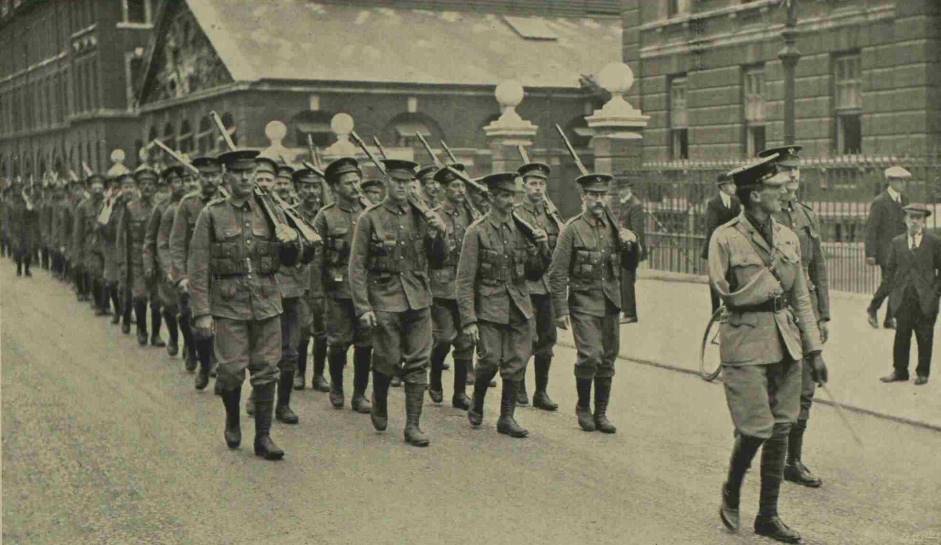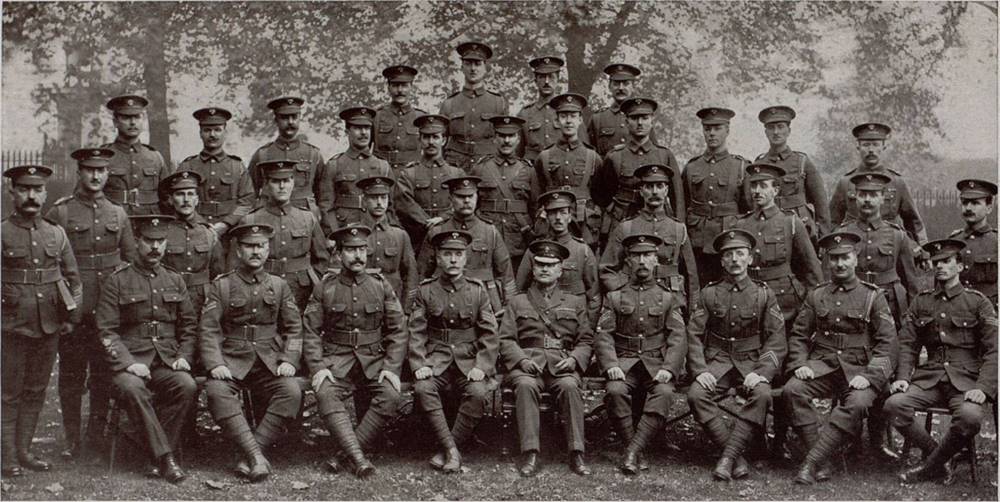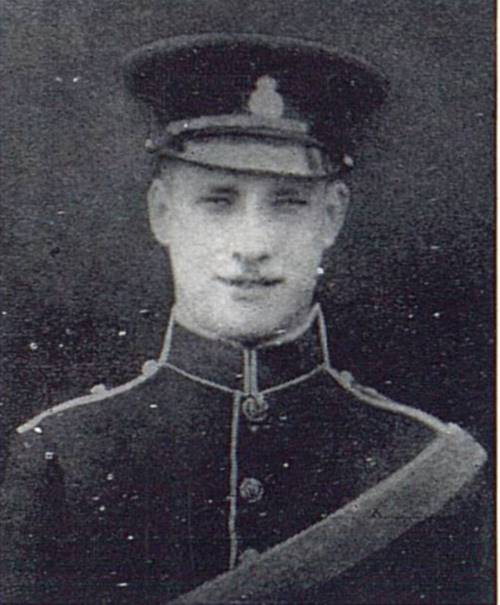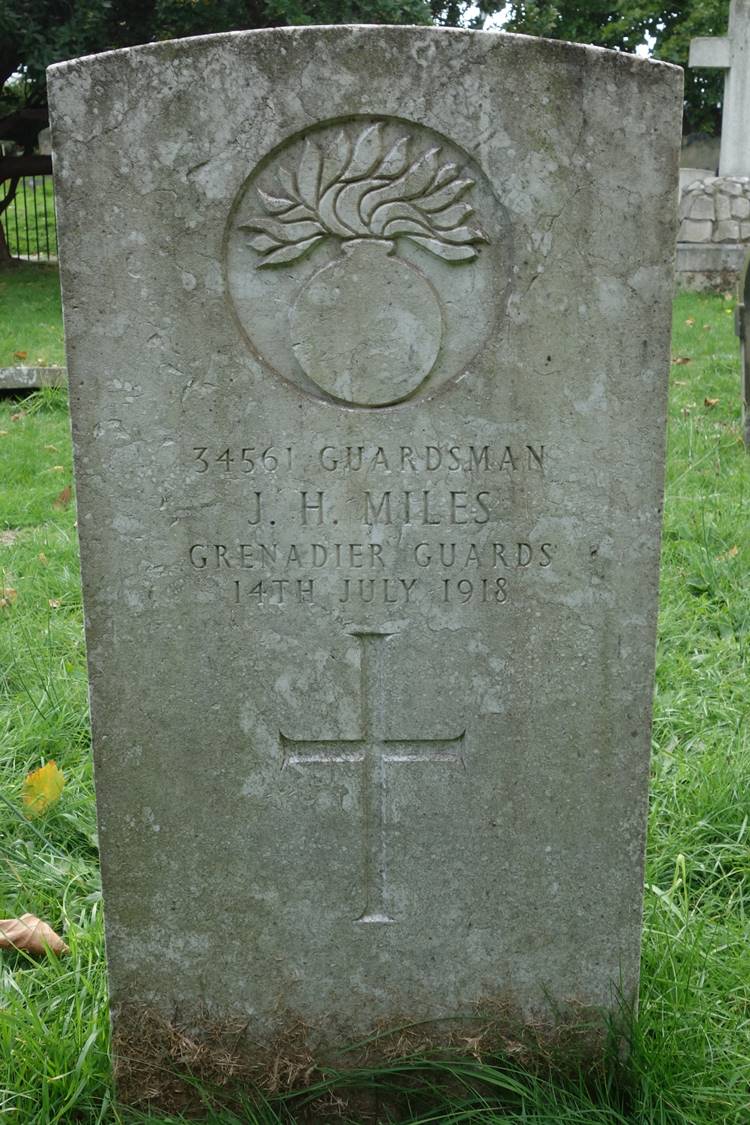This article looks at the service of the Grenadier Guards during the First World War and will help you to research soldiers who served with the Regiment. This is one of a series of guides I have created to help you research soldiers who served in the British Army during the war:
The Grenadier Guards in the First World War
To learn more about the Grenadier Guards battalions I’d recommend downloading the relevant war diaries and combining them with the regimental history. I’ve discussed these resources below.
1st Battalion Grenadier Guards
The 1st Battalion Grenadier Guards was stationed at Warley, Essex in August 1914. The Battalion landed at Zeebrugge, Belgium on 7 October 1914 as part of the 20th Brigade, 7th Division. In August 1915, the Battalion joined the 3rd Guards Brigade, Guards Division and served with this formation for the rest of the war. The Commonwealth War Graves Commission commemorates 1,279 officers and men of the Battalion who died between August 1914 and November 1918.
2nd Battalion Grenadier Guards
The 2nd Battalion was stationed at Chelsea Barracks, London on the outbreak of war and landed in France on 13 August 1914 as part of the 4th (Guards) Brigade, 2nd Division. In August 1915, the Battalion joined the 1st Guards Brigade, Guards Division and served with this formation for the remainder of the war. A total of 1,429 officers and men of the Battalion died between August 1914 and November 1918.
3rd Battalion Grenadier Guards
The 3rd Battalion was stationed at Wellington Barracks, London in August 1914 and landed in France on 27 July 1915. In August 1915, the Battalion joined the 2nd Guards Brigade, Guards Division and served with this formation for the remainder of the war. The Commonwealth War Graves Commission commemorated 959 officers and men of the Battalion who died between August 1914 and November 1918.
4th Battalion Grenadier Guards
The 4th Battalion was originally formed as a reserve battalion for the Regiment at Kensington in August 1914 and the same month moved to Chelsea Barracks. On the 14 July 1915, it was redesignated as the 5th (Reserve) Battalion and the same day the new 4th Battalion was formed at Marlow, Buckinghamshire. The 4th Battalion landed in France on 16 August 1915 where it served with the 3rd Guards Brigade, Guards Division. On 8 February 1918, the Battalion was transferred to the 4th Guards Brigade, 31st Division. In May 1918, the Battalion was transferred to the General Headquarters Reserve. The Commonwealth War Graves Commission commemorated 947 officers and men of the Battalion who died between August 1914 and November 1918.
5th (Reserve) Battalion Grenadier Guards
This Battalion started life at Kensington in August 1914 as the 4th (Reserve) Battalion and moved to Chelsea Barracks the same month. The battalion’s main role was to train drafts for the other battalions of the Regiment. On 14 July 1915, the 4th (Reserve) Battalion was redesignated as the 5th (Reserve) Battalion. It remained in Britain for the duration of the war. 
Researching Soldiers who Served in the Grenadier Guards
The Grenadier Guards’ Archive no longer holds the service records of those who served with the Regiment. Instead, you’ll have to apply to the Ministry of Defence using two forms which you can find on this link: Order Grenadier Guards Records. They are the British Army form where you write the details of the soldier, and either the next of kin or not next of kin form. You don’t need to be the next of kin to order First World War Grenadier Guards service records, providing the man in question was born over 116 years ago. Nor do you need to provide a death certificate.
Researching Officers: In general, you can usually find out a lot about Grenadier Guards officers. A service record is the key document to find but not all have survived to the present-day. There are 470 service records at the National Archives for Grenadier Guards officers. The MOD will hold the records of officers who served past April 1922 and may also hold additional records for officers who have records at the National Archives. You will need to look at the relevant war diary (see below) and also the regimental history. I would recommend searching newspapers, especially Tatler and The Sphere.
Second Lieutenant Robert Humphry Medlicott Vereker was the first Grenadier Guards officer to be killed in the war. Vereker was killed on 25 August 1914 near Landrecies “while trying to draw Corporal Bacchus, of his regiment, who was wounded, out of range of the German fire”. The quote is taken from Vereker’s Bond of Sacrifice entry, the portrait from The Illustrated London News, 9 September 1914 and there is a service record at the National Archives. The soldier Vereker was trying to save was 15004 Corporal Henry Bacchus who fell into German hands and survived the war. I was able to identity Bacchus by his unusual surname, as only one soldier served abroad with the Grenadier Guards allowing me to quickly find his medal index card and once I had his regimental number, find his prisoner of war records held by the International Red Cross.
Researching Other Ranks: I’d highly recommend applying for a soldier’s service record as this document will contain a lot of information you can’t find elsewhere. The Grenadier Guards’ archive no longer holds them as they have been transferred to the Ministry of Defence. For First World War soldiers you won’t need a death certificate as death is presumed at 116 years after birth: Order Grenadier Guards Record.
While you wait for a service record, start looking for medal records. The battalions a soldier served overseas should be recorded on their medal roll entry and you can download the relevant war diaries (see below). Casualty lists are always worth searching as the Grenadier Guards suffered heavy casualties during the war. The war diaries of the 4th Battalion recorded the names of many of the unit’s casualties with a regimental number. You’ll need to join both Ancestry and FindmyPast as both have different record sets for First World War soldiers. Fortunately, both offer a free trial and clicking on the banner below will take you to FindmyPast.
The headstone of 34561 Guardsman Jack Holston Miles 5th (Reserve) Battalion, Grenadier Guards who died on 14 July 1918 and is buried in the Brigade of Guards plot in Brompton Cemetery, London. Miles did not serve abroad so there will be few records available for him. The Commonwealth War Graves Commission records over 100 dead for the 5th Battalion and 14 are buried in Brompton Cemetery. The majority of the Battalion’s dead are men who were mortally wounded while serving with battalions on the Western Front and invalided back to Britain where they died of wounds. Once back in Britain, they were posted to the 5th Battalion but never joined it as they remained in hospital.
War Diaries of the Grenadier Guards
All of the war diaries recorded below have been digitized by the National Archives and can be downloaded for a small fee by clicking on the blue links below.
1st Battalion Grenadier Guards
- Date: 05 October 1914 – 31 July 1915
- 20th Infantry Brigade, 7th Division
- Reference: WO 95/1657/2
- Notes: Considering the period it covers, this isn’t the most detailed of war diaries.
- Date: 29 August 1915 – 16 February 1919
- 3rd Guards Brigade, Guards Division
- Reference: WO 95/1223/1
- Notes: Detailed entries when the Battalion was in action but not very detailed for the rest of the time. There are a handful of appendices including a narrative of operations carried out between 11 and 13 October 1918 and between 20 and 22 October 1918.
2nd Battalion Grenadier Guards
- Date: 12 August 1914 – 31 July 1915
- 4th Guards Brigade, 2nd Division
- Reference: WO 95/1342/1
- Notes: An average war diary.
- Date: 01 August 1915 – 31 January 1919
- 1st Guards Brigade, Guards Division
- Reference: WO 95/1215/1
- Notes: A good war diary with a lot of the entries being typed.
3rd Battalion Grenadier Guards
- Date: 26 July 1915 – 30 January 1919
- 2nd Guards Brigade, Guards Division
- Reference: WO 95/1219/1
- Notes: A good war diary with many detailed entries.
4th Battalion Grenadier Guards
- Date: 15 August 1915 – 1 February 1918
- 3rd Guards Brigade, Guards Division
- Reference: WO 95/1223/2
- Notes: A good war diary with many officers and men (with regimental numbers) mentioned throughout.
- Date: 02 February – 31 October 1918
- 4th Guards Brigade, Guards Division
- Reference: WO 95/1226/2
- Notes: A good war diary with a variety of interesting appendices including narratives of operations (opening of German Spring Offensive) and lists of men sent to the 1st Battalion in October 1918.
- Date: 01 November 1918 – 28 February 1919
- 3rd Guards Brigade, Guards Division
- Reference: WO 95/1223/3
- Notes: A good war diary with a variety of appendices.
Regimental History of the Grenadier Guards
The Grenadier Guards in the Great War 1914 – 1919 by Sir Frederick Ponsonby. This 3 volume set runs to over 1000 pages and has been reprinted by the Naval and Military Press. I have found volume 1 online at archive.org and you can read and download this volume for free by clicking below.
The Grenadier Guards in the Great War Volume 1
Further Sources for the Grenadier Guards
The Imperial War Museum contains a large collection of private papers written by officers and men of the Regiment during the war: Imperial War Museum Grenadier Guards Private Papers Collection. The first search is set to private papers only, the following search shows the entire Grenadier Guards’ collection: Grenadier Guards Collection.
A two-volume History of the Guards Division in the Great War 1915-1918 by Cuthbert Headlam was also published which is useful for putting the activities of the battalions in context with their higher formations. The history also contains very useful maps showing both the Brigades’ and Division’s boundaries for the major attacks along with their objectives or the position reached.
Another book which will be of interest if you’re researching a soldier who served with the 2nd Battalion Grenadier Guards between August and December 1914 is Fifteen Rounds A Minute: The Grenadiers at War 1914 which is a collection of accounts, including of Major “Ma” Jeffreys” edited by Michael Craster. This book was published in 1976 and has since been reprinted.


